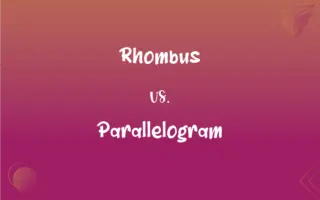Ferrocement Concrete vs. Reinforced Concrete: What's the Difference?
Edited by Aimie Carlson || By Janet White || Published on December 5, 2024
Ferrocement Concrete refers to thin layers of cement mortar reinforced with layers of mesh or metal. Reinforced Concrete refers to concrete strengthened with embedded steel bars (rebar).

Key Differences
Ferrocement concrete is a form of reinforced concrete but uses multiple layers of mesh or metal fibers, embedded in a cement mortar matrix. In contrast, traditional reinforced concrete primarily relies on steel bars (rebar) embedded within the concrete for strength. This difference in reinforcement materials and methods impacts their structural properties and applications.
The fabrication process of ferrocement concrete involves layering wire meshes and skeletal steel elements, then applying cement mortar. Reinforced concrete, however, is created by pouring concrete over a framework of steel rebar. The varying processes lead to different structural characteristics, with ferrocement offering more flexibility and thinner structures.
Ferrocement concrete is known for its thin, yet strong, structures and is often used in boat building, water tanks, and shell roofs. Reinforced concrete, due to its robustness and versatility, is a staple in large-scale construction like buildings, bridges, and roads. The usage reflects their distinct structural capabilities.
Cost-wise, ferrocement can be more labor-intensive due to the need for skilled labor to apply the layers precisely. In contrast, reinforced concrete is more straightforward in its construction process, often resulting in lower labor costs but potentially higher material costs due to the volume of concrete and steel used.
In terms of durability, ferrocement concrete is highly resistant to cracking, which makes it suitable for waterproof structures. Reinforced concrete, while strong, can suffer from corrosion of the steel rebar if not properly maintained, especially in corrosive environments.
ADVERTISEMENT
Comparison Chart
Reinforcement Material
Layers of mesh or metal fibers
Steel bars (rebar)
Construction Technique
Layering mesh with cement mortar
Pouring concrete over steel rebar framework
Structural Characteristics
Thin and flexible structures
Robust and versatile structures
Common Applications
Boat building, water tanks, artistic sculptures
Buildings, bridges, roads
Cost and Labor Intensity
More labor-intensive, requiring skilled application
Simpler process, potentially higher material costs
ADVERTISEMENT
Ferrocement Concrete and Reinforced Concrete Definitions
Ferrocement Concrete
It is a labor-intensive material, requiring skilled craftsmanship for layering.
Building the ferrocement concrete shell required meticulous work by the construction team.
Reinforced Concrete
It allows for the construction of large-scale and varied structures.
The architect designed a unique reinforced concrete structure that combined aesthetics with functionality.
Ferrocement Concrete
Ferrocement concrete is a composite material of cement mortar reinforced with fine metal meshes.
The artist used ferrocement concrete to create a delicate yet strong garden sculpture.
Reinforced Concrete
It is widely used in construction due to its durability and versatility.
Reinforced concrete is the preferred material for building overpasses and bridges.
Ferrocement Concrete
It is known for its thin profiles and high strength-to-weight ratio.
Ferrocement concrete was chosen for the boat hull due to its lightweight and durability.
Reinforced Concrete
Reinforced concrete can suffer from steel rebar corrosion if not properly maintained.
The reinforced concrete pier had to be repaired due to corrosion in the steel reinforcements.
Ferrocement Concrete
This material is versatile in shaping and forming complex curves.
Architects often prefer ferrocement concrete for curved architectural elements.
Reinforced Concrete
This material offers high compressive strength and resistance to heavy loads.
The parking garage was constructed with reinforced concrete to support the weight of numerous vehicles.
Ferrocement Concrete
Ferrocement is resistant to cracking and excellent for waterproof structures.
The ferrocement concrete water tank showed no signs of leakage even after years of use.
Reinforced Concrete
Reinforced concrete is a composite material combining concrete with embedded steel bars for added strength.
The foundation of the skyscraper was made with reinforced concrete to ensure stability.
FAQs
What are common uses of ferrocement concrete?
Common uses include boat building, water tanks, and artistic sculptures.
Where is reinforced concrete typically used?
It's widely used in large-scale constructions like buildings, bridges, and roads.
What is ferrocement concrete?
Ferrocement concrete is a type of reinforced concrete using layers of metal mesh and cement mortar.
Does reinforced concrete require maintenance?
Yes, especially to prevent corrosion in the steel reinforcement.
Does reinforced concrete contribute to urban heat islands?
Yes, like most concrete surfaces, it can contribute to urban heat islands.
What is reinforced concrete?
Reinforced concrete is concrete strengthened with steel bars (rebar) for enhanced structural integrity.
Is ferrocement concrete flexible?
Yes, it is known for its flexibility and thin structures.
Is ferrocement concrete expensive?
It can be more labor-intensive, thus potentially costlier in terms of skilled labor.
How does ferrocement concrete differ from traditional reinforced concrete?
Ferrocement uses mesh layers for reinforcement, while traditional reinforced concrete uses steel bars.
Is reinforced concrete recyclable?
Yes, to some extent, particularly the steel rebar component.
What are the thermal properties of ferrocement concrete?
It generally has good thermal properties but is not typically used for insulation.
How does the weight of reinforced concrete compare to other building materials?
It's heavier than materials like wood, but its strength-to-weight ratio is favorable for many structures.
Can reinforced concrete handle heavy loads?
Yes, its high compressive strength makes it ideal for heavy loads.
How durable is ferrocement concrete?
It's highly durable and resistant to cracking.
Can ferrocement concrete be used in earthquake-prone areas?
Its flexibility makes it a good option for seismic areas.
Is reinforced concrete suitable for high-rise buildings?
Yes, it's a primary material for high-rise constructions due to its strength and durability.
Can ferrocement concrete be used for artistic purposes?
Absolutely, its versatility makes it suitable for artistic and sculptural applications.
What are the environmental impacts of using ferrocement concrete?
Like other concretes, it has an environmental impact related to cement production, but its thinner profiles can reduce material usage.
Can ferrocement concrete be used for flooring?
It's not typically used for flooring due to its thin nature and labor-intensive installation.
Is reinforced concrete resistant to fire?
Yes, it has good fire-resistant properties, making it a safe choice for many buildings.
About Author
Written by
Janet WhiteJanet White has been an esteemed writer and blogger for Difference Wiki. Holding a Master's degree in Science and Medical Journalism from the prestigious Boston University, she has consistently demonstrated her expertise and passion for her field. When she's not immersed in her work, Janet relishes her time exercising, delving into a good book, and cherishing moments with friends and family.
Edited by
Aimie CarlsonAimie Carlson, holding a master's degree in English literature, is a fervent English language enthusiast. She lends her writing talents to Difference Wiki, a prominent website that specializes in comparisons, offering readers insightful analyses that both captivate and inform.







































































